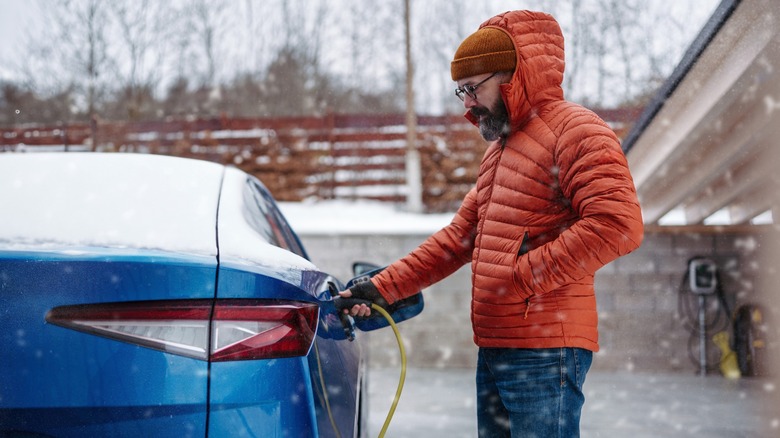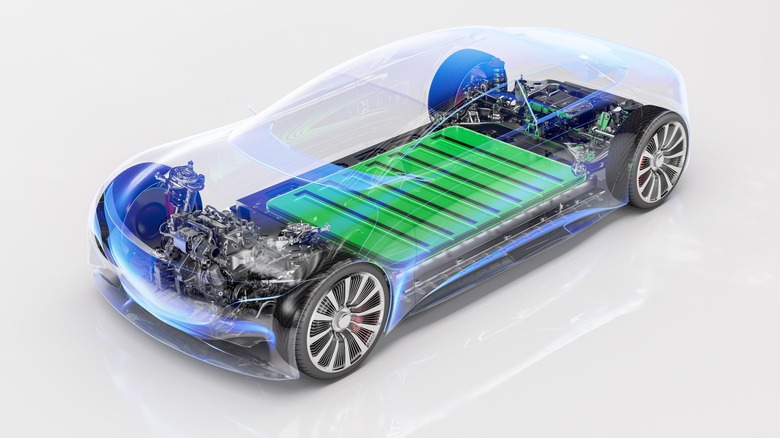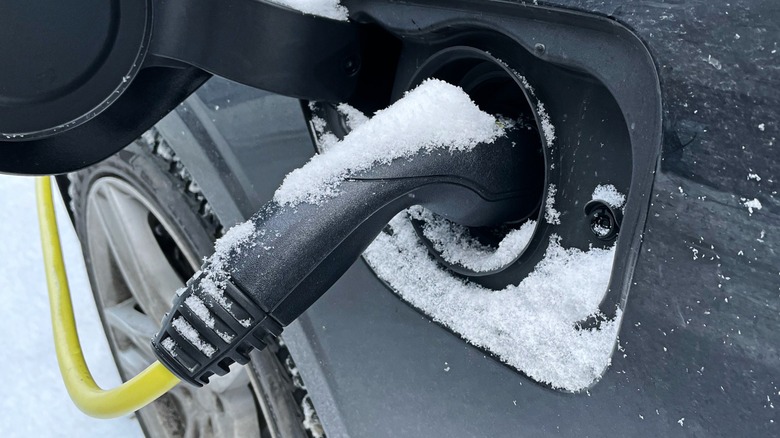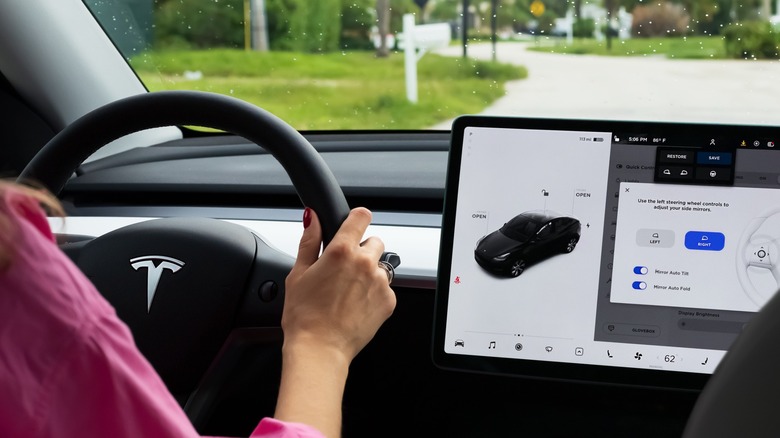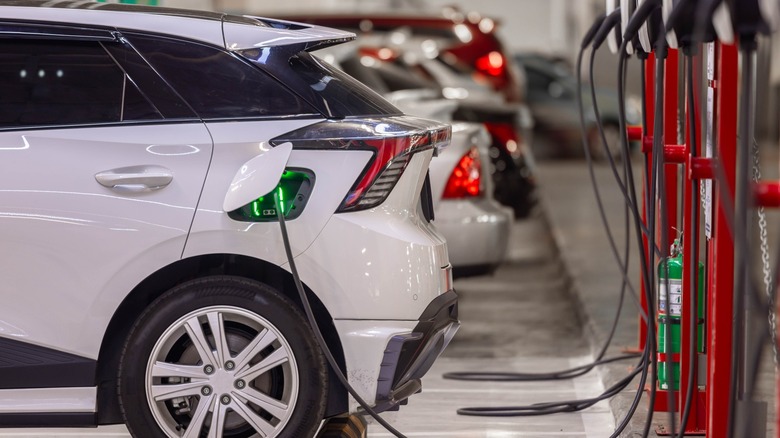3 Benefits Of Pre-Conditioning Your Electric Vehicle
Electric vehicles are pretty cool. When you start driving one, you'll notice how quiet, fast, and low maintenance they are compared to cars with internal combustion engines — but let's be honest: as great as EVs are, they're not perfect. It's pretty frustrating when the range suddenly drops or when charging takes much longer than usual.
Now, these issues are not signs that something's wrong with your car, it's more likely to just be your battery reacting to extreme weather. In fact, the data-crunchers at Geotab found that extreme temperatures can reduce your EV's range by more than 40 percent. That's a significant chunk of travel time gone, and it's usually the beginning of range anxiety for many drivers.
But why does this happen? The reason is simple: lithium-ion batteries don't cope well with temperature changes. When the weather gets too hot or too cold, the chemical reactions inside the battery slow down, making it less efficient.
However — and not many EV owners know this — there's a feature called pre-conditioning that preps your car's battery to handle the shift in temperature better. In this article, we'll break down how pre-conditioning works, why it's so important, and how it can possibly cure any range anxiety you may have.
How does pre-conditioning an EV work?
Pre-conditioning makes more sense when you understand how an EV battery works. Most electric vehicles are powered by lithium-ion batteries, which are particularly sensitive to drastic changes in temperature. The ions inside these batteries travel through a liquid electrolyte to generate energy. When the weather gets colder, the liquid electrolyte becomes thicker, creating a form of resistance that makes the ions move at a much slower pace.
That's also why, on a really cold day, you may notice your battery takes longer to even begin charging. When you plug in a cold EV, the energy it draws from the charger doesn't immediately go into charging the battery. Instead, it warms up the battery first, bringing it up to a more suitable temperature where there's less resistance for the ions to travel. Only when the battery reaches that ideal temperature range can it begin accepting and holding a charge efficiently.
However, it's annoying for drivers if they have to wait hours for their EVs to charge on a really cold day, and that's where pre-conditioning comes in. It's a feature that's designed to prepare your battery ahead of time to receive a charge. What exactly does that mean? Well, let's say you're on your way to the charging station to use a supercharger. Once you enable pre-conditioning, the system starts warming the battery as you're on your way. By the time you arrive at the charging station, you'll find that the battery is warm and ready to receive the charge.
It offers comfort and convenience
Pre-conditioning shaves off all that time you may have spent waiting for your car's battery to warm up to receive a charge. At first, it might seem so simple that you wonder if it really makes a difference. In fact, many drivers have this misconception that, even without pre-conditioning, the drive to the supercharger should warm up the battery enough to receive a charge efficiently.
Well, you have to remember that electric cars work in a different way to internal combustion engine cars. An internal combustion engine generates a lot of waste heat while burning fuel, but EVs are more efficient, producing far less excess heat. As a result, the battery doesn't get as warm. Also, the airflow beneath the car in the thick of winter quickly cools what little heat there is.
Therefore, when arriving at a supercharger, the battery, still relatively cold, will charge more slowly. However, with pre-conditioning your battery is warmed up and ready to receive a full charge the minute you arrive at the charging station.
Now, while you can pre-condition your battery, you can also pre-condition your car. That means you don't have to get into an utterly cold vehicle when you're ready to drive. All you need to do is schedule your departure time and plug in your car, and your EV will activate climate control so that by the time you're ready to drive out of your garage, the seats are warm, your windows are clear, and you have good visibility of the road.
It preserves your battery health
Considering how expensive it is to replace an EV battery, you should take advantage of every measure to protect the one you have, so it lasts longer and serves you well. When you think about it, an EV's battery isn't much different from any other type of battery — they all have a limited life cycle. That's why manufacturers often advise against regularly charging your EV to 100 percent, or letting it drop to zero too often. Both extremes put unnecessary strain on the battery, gradually affecting its capacity and performance over time.
In extreme weather conditions, when the battery operates outside its ideal temperature range — usually between 60 and 95 degrees Fahrenheit – the chemical reactions inside slow down. As the ions struggle against the resistance, the battery works harder, and its charge depletes much faster. This means that in the cold, you run out of power more quickly, and because you still need to move around, you'll plug it back in. This sudden temperature shift between hot and cold, a concept known as thermal cycling, wears down the battery's structure, and over time this strain causes the battery to degrade faster, losing efficiency and shortening its overall lifespan.
This is where pre-conditioning is a huge help. By keeping the battery at the right temperature, pre-conditioning eases that stress, allowing the chemical reactions inside to occur more smoothly.
It boosts the battery's immediate performance and preserves its long-term health. With less thermal cycling and the battery working at the ideal temperature, your battery stays efficient, which could save you from spending so much on an untimely replacement.
It optimizes your EV's range
It's easy to think that pre-conditioning adds miles to your range, but the truth is, it doesn't. What it does is help you make the most of your car's range. When it's really cold outside, and you skip the pre-conditioning, your battery ends up using a lot of its energy just to warm itself up, which means you'll lose miles in range. This is often the start of range anxiety for many drivers: the fear that you won't have enough battery power to reach your destination when, under normal circumstances, you should.
So, how does pre-conditioning help if it doesn't actually add miles? Well, it helps you save the miles you'd otherwise lose. When you plug in your EV at home and enable the pre-conditioning feature, it uses electricity from the grid to warm the battery, instead of draining your car's own battery. That way, when you start driving, your car can focus all its energy on moving, rather than warming itself up to operate efficiently.
It's also true that when the battery is cold, your car can't fully take advantage of regenerative braking, a smart feature that recovers some of the energy used when braking and sends it back to the battery, essentially giving it a small charge.
Pre-conditioning will help your battery work at an efficient temperature, so that you can enjoy your optimal range, and allow regenerative braking to operate effectively.
How much does it cost to pre-condition your car?
Pre-conditioning works whether or not the car is connected to a charger, although it's much more efficient when you're plugged into an external power source. It uses a small amount of power, and the cost really depends on how cold it is and how much energy your car's battery needs to warm up.
However, as an example, a car could draw around 2.5 kW to generate heat when plugged in. With the average electricity rate in the United States at around $0.16 per kWh, if your EV uses 2.5 kWh to pre-condition both the battery and cabin, you're looking at about $0.40 per session. If you pre-condition your car every day during winter, this could add up to roughly $12 a month. In states with higher electricity rates, like California, where the rate is closer to $0.40 per kWh, the price would rise to about $1.00 per session or around $30 monthly.
Of course, this is a rough estimate, but, when you consider the benefits of pre-conditioning, from the comfort of a warm car in winter to an efficient battery that maintains your range, it's easy to justify the expense.
Do all EVs have a pre-conditioning feature?
Some older or inexpensive EVs might not come equipped with a pre-conditioning feature, but considering how convenient and beneficial it is, you will find it in most mid-range to high-end models from brands like Tesla, Mercedes, Nissan, and Ford. Typically, you can activate it remotely using a connected smartphone app or through the car's navigation system. In some cases, pre-conditioning is even enabled automatically by the manufacturer.
For example, in Tesla vehicles, pre-conditioning automatically kicks in when you schedule a trip and enter a charging station as the destination. This makes sure the battery warms up to the right temperature for faster and more efficient charging by the time you arrive. It's especially helpful when you're using a supercharger in the thick of winter. While the process of starting pre-conditioning may vary depending on the car, most modern EVs make it simple and straightforward.
